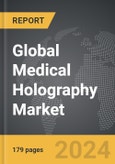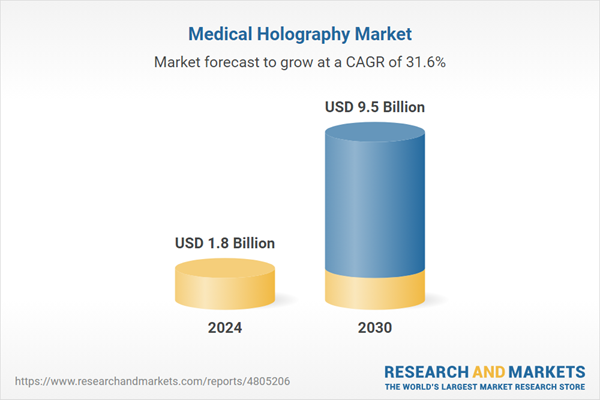The global market for Medical Holography was valued at US$1.8 Billion in 2024 and is projected to reach US$9.5 Billion by 2030, growing at a CAGR of 31.6% from 2024 to 2030. This comprehensive report provides an in-depth analysis of market trends, drivers, and forecasts, helping you make informed business decisions. The report includes the most recent global tariff developments and how they impact the Medical Holography market.
Segments: Product Type (Holographic Display, Holographic Microscope, Holographic Software, Holoscopes, Holographic Print); Application (Medical Imaging, Medical Education, Biomedical Research).
Geographic Regions/Countries: World; United States; Canada; Japan; China; Europe (France; Germany; Italy; United Kingdom; and Rest of Europe); Asia-Pacific; Rest of World.
The analysts continuously track trade developments worldwide, drawing insights from leading global economists and over 200 industry and policy institutions, including think tanks, trade organizations, and national economic advisory bodies. This intelligence is integrated into forecasting models to provide timely, data-driven analysis of emerging risks and opportunities.
Global Medical Holography Market - Key Trends & Drivers Summarized
What Is Medical Holography and How Is It Revolutionizing Healthcare?
Medical holography refers to the use of holographic technology to create three-dimensional images for medical purposes, significantly enhancing visualization in diagnostic and therapeutic applications. This cutting-edge technology is used to generate detailed and accurate 3D representations of complex anatomical structures, providing an invaluable tool for physicians, surgeons, and educators. The application of medical holography ranges from advanced imaging techniques in diagnostics, pre-surgical assessments, and medical education to real-time image guidance during surgical procedures. The ability of holographic imaging to provide a depth-perception and spatial awareness unmatched by traditional 2D imaging techniques dramatically improves the understanding of anatomical relationships and the precision of medical interventions. As medical professionals continue to seek more immersive and interactive ways to visualize and interact with patient data, medical holography is becoming increasingly critical in delivering sophisticated healthcare solutions.How Are Technological Advancements Enhancing Medical Holography Capabilities?
The medical holography market is rapidly evolving, driven by continual technological advancements that enhance the clarity, accessibility, and usability of holographic displays and imaging techniques. Innovations in laser technology, digital processors, and visualization software have significantly improved the resolution and realism of holographic images. Additionally, the integration of augmented reality (AR) and virtual reality (VR) with holographic systems has opened new avenues for immersive training and complex surgical rehearsals. These technological enhancements not only broaden the application scope of medical holography but also make these advanced visualizations more practical and effective in clinical settings. Furthermore, the miniaturization of hardware and the advent of portable holographic devices are expanding the use of holography in routine medical practices, allowing for bedside imaging and diagnostics, thereby improving patient care and treatment outcomes.What Role Does Collaboration Play in Advancing Medical Holography Innovations?
Collaboration among tech companies, research institutions, and healthcare providers plays a pivotal role in the advancement of medical holography. Joint efforts are essential for driving innovation, from research and development in holographic technology to its practical applications in healthcare. Collaborations help bridge the gap between technological possibilities and clinical needs, ensuring that the developments in holography are both medically relevant and technologically sound. These partnerships often lead to groundbreaking applications that can transform medical procedures and training. For example, collaborations have led to the development of holographic navigation systems used during surgeries, which improve accuracy and reduce risks. Additionally, educational partnerships are enhancing medical training and patient understanding of complex medical conditions through detailed 3D visualizations, making medical information more accessible and comprehensible.Growth in the Medical Holography Market Is Driven by Several Factors
The growth in the medical holography market is driven by several factors, emphasizing the demand for enhanced imaging techniques in the healthcare sector. The increasing complexity of surgical procedures and the need for precise anatomical visualizations are significant drivers. Technological innovations that deliver more detailed and interactive imaging solutions are also crucial to market expansion. Moreover, the growing application of holography in medical education and training, where detailed anatomical models are essential, contributes to the rising demand. Regulatory approval for new and innovative holographic devices and systems also accelerates market growth, allowing wider adoption in clinical settings. Additionally, the expansion of minimally invasive surgery and personalized medicine, where precise imaging directly impacts treatment outcomes, further propels the adoption of medical holography. These factors, combined with an increasing emphasis on patient safety and surgical efficacy, ensure a dynamic growth trajectory for the medical holography market.Report Scope
The report analyzes the Medical Holography market, presented in terms of units. The analysis covers the key segments and geographic regions outlined below.Segments: Product Type (Holographic Display, Holographic Microscope, Holographic Software, Holoscopes, Holographic Print); Application (Medical Imaging, Medical Education, Biomedical Research).
Geographic Regions/Countries: World; United States; Canada; Japan; China; Europe (France; Germany; Italy; United Kingdom; and Rest of Europe); Asia-Pacific; Rest of World.
Key Insights:
- Market Growth: Understand the significant growth trajectory of the Holographic Display segment, which is expected to reach US$5.6 Billion by 2030 with a CAGR of a 31.4%. The Holographic Microscope segment is also set to grow at 34.2% CAGR over the analysis period.
- Regional Analysis: Gain insights into the U.S. market, valued at $509.7 Million in 2024, and China, forecasted to grow at an impressive 29.9% CAGR to reach $1.4 Billion by 2030. Discover growth trends in other key regions, including Japan, Canada, Germany, and the Asia-Pacific.
Why You Should Buy This Report:
- Detailed Market Analysis: Access a thorough analysis of the Global Medical Holography Market, covering all major geographic regions and market segments.
- Competitive Insights: Get an overview of the competitive landscape, including the market presence of major players across different geographies.
- Future Trends and Drivers: Understand the key trends and drivers shaping the future of the Global Medical Holography Market.
- Actionable Insights: Benefit from actionable insights that can help you identify new revenue opportunities and make strategic business decisions.
Key Questions Answered:
- How is the Global Medical Holography Market expected to evolve by 2030?
- What are the main drivers and restraints affecting the market?
- Which market segments will grow the most over the forecast period?
- How will market shares for different regions and segments change by 2030?
- Who are the leading players in the market, and what are their prospects?
Report Features:
- Comprehensive Market Data: Independent analysis of annual sales and market forecasts in US$ Million from 2024 to 2030.
- In-Depth Regional Analysis: Detailed insights into key markets, including the U.S., China, Japan, Canada, Europe, Asia-Pacific, Latin America, Middle East, and Africa.
- Company Profiles: Coverage of players such as EchoPixel, Inc., EON Reality, Inc., HoloxiCA Ltd., Lyncee Tec SA, Mach7 Technologies Ltd. and more.
- Complimentary Updates: Receive free report updates for one year to keep you informed of the latest market developments.
Some of the 12 companies featured in this Medical Holography market report include:
- EchoPixel, Inc.
- EON Reality, Inc.
- HoloxiCA Ltd.
- Lyncee Tec SA
- Mach7 Technologies Ltd.
- Nanolive SA
- Ovizio Imaging Systems Nv/Sa
- Realview Imaging Ltd.
- zSpace, Inc.
Tariff Impact Analysis: Key Insights for 2025
Global tariff negotiations across 180+ countries are reshaping supply chains, costs, and competitiveness. This report reflects the latest developments as of April 2025 and incorporates forward-looking insights into the market outlook.The analysts continuously track trade developments worldwide, drawing insights from leading global economists and over 200 industry and policy institutions, including think tanks, trade organizations, and national economic advisory bodies. This intelligence is integrated into forecasting models to provide timely, data-driven analysis of emerging risks and opportunities.
What’s Included in This Edition:
- Tariff-adjusted market forecasts by region and segment
- Analysis of cost and supply chain implications by sourcing and trade exposure
- Strategic insights into geographic shifts
Buyers receive a free July 2025 update with:
- Finalized tariff impacts and new trade agreement effects
- Updated projections reflecting global sourcing and cost shifts
- Expanded country-specific coverage across the industry
Table of Contents
I. METHODOLOGYII. EXECUTIVE SUMMARY2. FOCUS ON SELECT PLAYERSIII. MARKET ANALYSISIV. COMPETITION
1. MARKET OVERVIEW
3. MARKET TRENDS & DRIVERS
4. GLOBAL MARKET PERSPECTIVE
UNITED STATES
CANADA
JAPAN
CHINA
EUROPE
FRANCE
GERMANY
ITALY
UNITED KINGDOM
REST OF EUROPE
ASIA-PACIFIC
REST OF WORLD
Companies Mentioned (Partial List)
A selection of companies mentioned in this report includes, but is not limited to:
- EchoPixel, Inc.
- EON Reality, Inc.
- HoloxiCA Ltd.
- Lyncee Tec SA
- Mach7 Technologies Ltd.
- Nanolive SA
- Ovizio Imaging Systems Nv/Sa
- Realview Imaging Ltd.
- zSpace, Inc.
Table Information
| Report Attribute | Details |
|---|---|
| No. of Pages | 179 |
| Published | April 2025 |
| Forecast Period | 2024 - 2030 |
| Estimated Market Value ( USD | $ 1.8 Billion |
| Forecasted Market Value ( USD | $ 9.5 Billion |
| Compound Annual Growth Rate | 31.6% |
| Regions Covered | Global |









